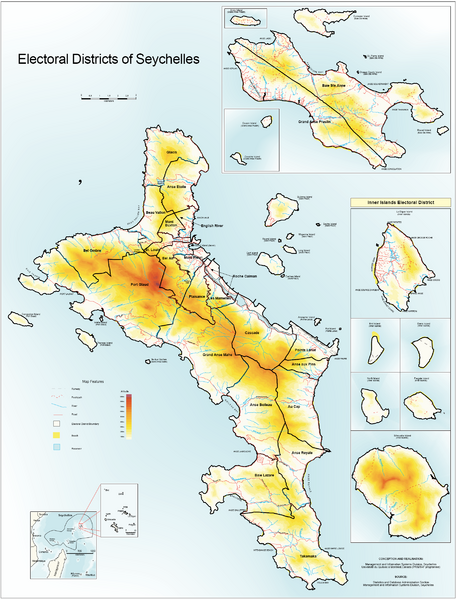The following are electoral systems that have been used to elect the unicameral National Assembly of the Seychelles (Lasanble Nasyonal Sesel). Since 1994, the Constitution has required that there be at least 19 constituencies on Mahe, 2 on Praslin, and 1 on the Inner Islands.
SEYCHELLES 1 (1993)
At the time of the 1993 elections, there were 22 single-member constituencies (SMCs) with MPs elected by the single-member plurality system. Votes cast in the SMCs were aggregated to award seats equal in number to one-half of the SMCs (disregarding any fraction) by the largest remainder method of proportional representation with a Hare quota. The Hare quota was equal to the number of valid votes divided by the number of seats (i.e. 11). Seats were first distributed for full Hare quotas with any leftover seats given out to parties in descending order of remainder votes (i.e. votes not used towards a full Hare quota and seat). Parties needed to receive 8% of the vote in order to qualify to receive PR seats.
1993 Constitution of the Republic of Seychelles
1993 Constitution of the Republic of Seychelles as Amended through 20111996 Elections Act
SEYCHELLES 2 (1998-2007)
The number of SMCs increased to 25. The system for allocating PR seats was changed, so that one seat was awarded for each full 10% of the valid vote received. Parties needed to receive 10% of the vote to qualify to receive any seats and there were a maximum of 10 PR seats. Nine PR seats were awarded in each of the three elections held under the system.
SEYCHELLES 3 (2011-)
In 2011, the Electoral Commission decided to allocate PR seats to parties based on 10% of all votes cast (i.e. including blank and invalid votes). This decision was challenged unsuccessfully in a court case, Popular Democratic Movement v. Electoral Commission. The change increased substantially the required number of votes needed to receive a PR seat in 2011 due to the large number of blank and invalid votes. The number of PR seats awarded in 2011 was 6 and the change prevented the largest opposition party from receiving a PR seat. In 2016, 8 PR seats were awarded – 4 to each of the two largest parties.
EISA Technical Assessment Team Report: 2011 Presidential Election including Results by District
SADC Electoral Observer Mission Statement: 2011 Presidential Elections
Report of the Commonwealth Expert Team: 2011 Presidential Election
Dhanjee v. Electoral Commissioner (2011) SLR 117
SADC Electoral Observer Mission Preliminary Statement: 2011 Parliamentary Elections
Popular Democratic Movement v. Electoral Commission (2011) SLR 354

